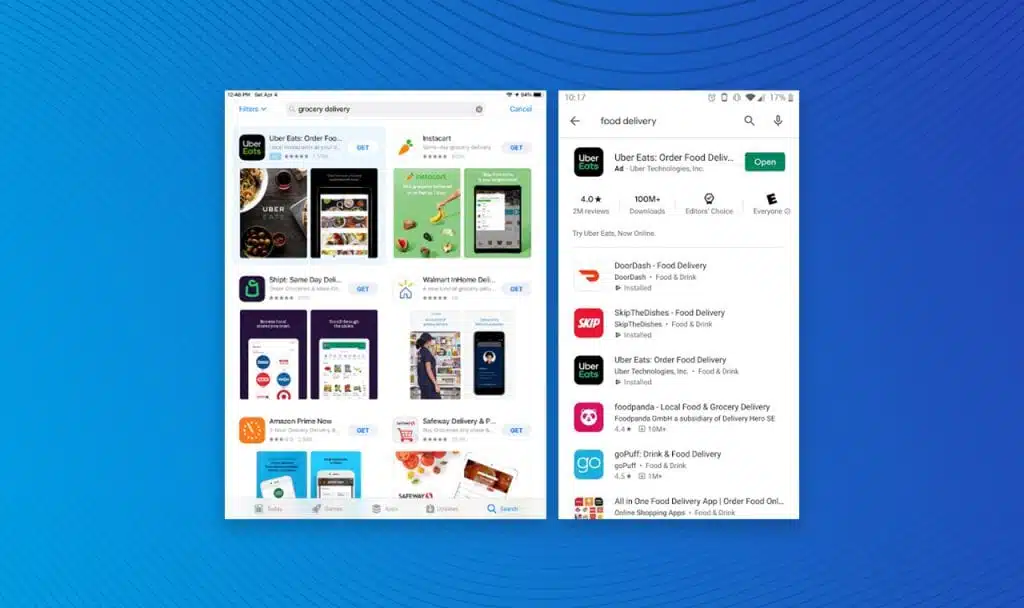Table of Contents
Have you been struggling to make your mobile app stand out amongst your competitors?
To successfully increase visibility, conversion rates, ranking, and downloads, consider implementing different promotional tactics. Strategies like content marketing, app store advertising (such as Apple Search Ads, or Google Play Ads), as well as email marketing, and lead generation are all popular approaches. While there are multiple marketing directions you can take, there are a few key strategies that will help you achieve your goals in the short term, and boost the visibility of your mobile application. In this post, we will first explore the importance of App Store Optimization (or ASO). We will then take a look at how app store ads can be used alongside ASO to further increase your mobile app exposure and overall conversions.
A Closer Look at ASO Marketing
So, what exactly is ASO? Similar to Search Engine Optimization (SEO), ASO helps increase traffic within Google Play or Apple App Store. App stores are equipped with their own, internal search engines and algorithms that help determine which apps will be shown to the user when certain words are searched for. These algorithms also reveal how often your mobile app is being viewed. Running an effective ASO strategy will increase the likelihood of your product being discovered by your target consumers when they are searching.
In 2017, mobile users downloaded 178 billion apps, and that number only continues to grow! This is why it’s important to optimize your product with mobile app marketing best practices. Especially if you’re in a competitive industry. If you’re developing a new application, tapping into app store optimization can give your brand an edge, increase your exposure, and boost revenue. With over 3602 apps submitted EACH DAY to the Apple Store alone, you need to make your product stand out from the rest!
The best way to optimize your app is through metadata, keywords, compelling content and imagery. Video previews can also provide a significant advantage, as they quickly explain the benefits and features of your application. Make sure you include relevant and understandable text that explains the features effectively. Informative screenshots showing the app in-use can speak volumes. You should also create an engaging icon. The icon you use is essentially your app’s logo, so it’s crucial to make it memorable and recognizable to users. Think of Facebook or Instagram, and you automatically envision their icon. Strive for the same when creating your app.
To enhance your mobile app marketing strategy even further, try combining ASO best practices with App Store Ads (ASA) such as Apple Search Ads and Google Ad Campaigns. Read on for more information about this unstoppable duo.
Advantages of Combining Paid-for Ads with ASO for a Bullet-Proof Mobile App Marketing Strategy
Think of running Apple Search Ads and Google Ad campaigns as your secret weapon. Do it right, and you can boost your application to the top, so it’s the first product your target audience sees when searching. Here are some of the main benefits:
- Visibility & Exposure: Properly targeted paid-for ads, merged with ASO best practices, will drastically increase the visibility of your app. This is especially important in very popular genres where thousands of apps are fighting for attention. In essence, adding paid-for ads will help your app ‘cut the line’ in order to show up first, allowing you to be at the top of the list – and in your searchers’ mind!
- Downloads & Revenue: With increased visibility comes increased downloads and higher conversion rates. Moreover, paid ads could bring more organic installs through multiple taps. The more an ad is clicked on, the higher the relevancy – according to the search algorithm used.
Whether you choose to seek advice from ad experts, or do it yourself, there are many aspects to consider. So let’s look at how to use your ads successfully to reach your target audience.
Using Paid-for Mobile Ads Effectively
Unfortunately, it’s not just as simple as paying for an add and voilá – increased downloads and profit! Developers and marketers need to focus on usability, creativity, explanation, examples, user experience, metadata, keywords, and more to convert searches into downloads. To gain ad space, you must first set a budget and bid on keywords related to your app – and that your customers will search for. It’s estimated that over 70% of App Store users find their desired download from the search bar. So, choosing the most effective, relevant keywords can drastically increase your app’s exposure and success.
A better understanding of these words, phrases, and relevant searches will give you an advantage when bidding on keywords. In the end, it really comes down to how relevant your app is compared to the word(s) searched. While understanding your consumer is important, competitor awareness is also pertinent. When researching your competitors, try to find the most popular apps that are similar to yours and analyze which keywords are being used throughout their titles and descriptions. This will give you a better understanding of which words to use yourself.
The example above demonstrates how you can type in a term to see the popularity of the recommended keywords to use. Popular keywords will help strengthen the searchability of your product.
Implementing Google & Apple Search Ads
Looking to create an app for iOS, Android, or both? We’ll shed some light on how to use each store to your advantage.
Apple’s App Store
Apple search ads are fairly new, meaning there are still opportunities for improvement, which they are constantly working on. Because of this, you can capitalize on the lower costs of advertising with Apple.
Apple has two main packages to choose from: basic, or advanced. The basic plan doesn’t allow you to use keywords or define your audience. You can only select your budget and target countries. Apple then uploads the ad based on those two factors. The advanced package is much more search-oriented. It lets you enhance your search ads creative set (subtitles and app store descriptions) to help boost your ranking and visibility. If you choose this route, it’s important to focus your attention on a precise, keyword-specific optimization plan. The more combinations of keywords you can come up with, the better.
Using Apple’s Search Match tool will also allow you to find even more relevant keywords. Keeping this function on will help match your ad to new words you may not have thought of, and list other comparable apps in the same industry. This will give you a better idea of what your competitors are doing.
Understanding the best keywords to use, is probably one of the most effective features of Apple Search Ads. Implementing these keywords can give you a huge advantage when it comes to understanding your consumer and gaining an edge.
In the Apple Search Ad example on the left, the words ‘grocery delivery’ were used.
The example above demonstrates how you can type in a term to see the popularity of the recommended keywords to use. Popular keywords will help strengthen the searchability of your product.
The top result was an ad by UberEats. The word ‘ad’ is mentioned next to the star ratings, showing that UberEats pays for advertising space and bids on keywords to enhance their visibility. In their keyword bank and metadata, they would have used words similar to ‘grocery’ and ‘delivery’ to show up at the top of the search. Not only that, but they are a well-known brand, so we can assume that their conversion rate is high. This also increases their chances of being at the top of the list organically. You’ll notice that all the apps in this picture use visually appealing screenshots, which is especially important to attract attention from your ads.
Apple Search Ads also allows you to check conversions, tap-throughs, downloads, impressions, and run A/B tests to gauge which campaigns are the most effective.
Google Play Ads
Google introduced Google Play Search Ads back in 2015. Like Apple, it continues to improve and advance its features. The algorithm used in Google’s store is known for being very intricate.
Google’s Universal Ad Campaign allows your app to not only be seen in the Google Play store but across other Google-owned streams such as YouTube, the Google search engine, Gmail, and other related platforms. Google takes your tailored ad campaign and helps you advertise it across these other streams to increase your conversion and download rates.
Best Practices
Through the Google Play developer’s console, you’re able to set up your ad campaign seamlessly with the keywords that are most relevant to your title and descriptions. You can even set your budget for advertising, and determine where you’d like to target around the globe. Google will then automatically generate your ad campaign for you and promote it across Google’s suite of networks.
Like any ad campaign, you need to choose your keywords and design creative sets wisely. But, with Google, the bidding process is equally important. What are you willing to pay per install? In other words, what is each download worth to you? From here, you can determine your daily budget. For example, if you set a monthly budget of $100 and only want to make a bid for $5 per download, then you’re saying that you’ll pay for 50 downloads a month.
Pro tip: CPI (Cost Per Install) differs by industry. This Google Ads Guide explains the different types of costs to consider for your campaign.
Like Apple, Google allows you to work with keywords and decide how closely you’d like the user’s actual search to match the ones used in your ad. You can also track downloads, installs, progress and revise your campaigns as needed. But, unlike Apple, Google doesn’t allow you to set up a keyword bank. This means that the keywords you choose for your title and descriptions are the most important for your strategy. Because the algorithms are different between the two stores, you won’t be able to simply copy and paste the same information from one over to the other.
If you look back at the previous image at the Google Play Store example, you can see that UberEats lands on top because of their paid advertisement (the word ‘ad’ in bold is visible under the word ‘Uber’). The visuals don’t play quite as big a role as they do in the Apple App Store. Instead, the app itself gives you a better idea of user reviews and number of downloads. So rather than focusing on visuals, UberEats would have had to optimize their titles and descriptions with the most related keywords.
Use Both & Watch Your Apps Soar
The world of mobile apps is competitive, but you can increase your success through effective app store advertising. To stand out among your competitors, you must first understand the keywords associated with your app. Combine this with innovative visuals and icons to compel your audience to click. Then implement ASO best practices so that when the user reaches your product page they see engaging descriptions and creatives. Do these things well, set an appropriate budget for advertising, and watch your app gain traction!







